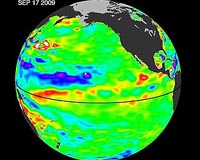| . |  |
. |
Pasadena CA (JPL) Mar 22, 2010 El Nino 2009-2010 just keeps hanging in there. Recent sea-level height data from the NASA/European Ocean Surface Topography Mission/Jason-2 oceanography satellite show that a large-scale, sustained weakening of trade winds in the western and central equatorial Pacific during late-January through February has triggered yet another strong, eastward-moving wave of warm water, known as a Kelvin wave. Now in the central and eastern equatorial Pacific, this warm wave appears as the large area of higher-than-normal sea surface heights (warmer-than-normal sea surface temperatures) between 150 degrees west and 100 degrees west longitude. A series of similar, weaker events that began in June 2009 initially triggered and has sustained the present El Nino condition. JPL oceanographer Bill Patzert says it's too soon to know for sure, but he would not be surprised if this latest and largest Kelvin wave is the "last hurrah" for this long-lasting El Nino. Patzert explained, "Since June 2009, this El Nino has waxed and waned, impacting many global weather events. I,and many other scientists, expect the current El Nino to leave the stage sometime soon. What comes next is not yet clear, but a return to El Nino's dry sibling, La Nina, is certainly a possibility, though by no means a certainty. We'll be monitoring conditions closely over the coming weeks and months." An El Nino also causes unusual changes in atmospheric circulation and convection around the globe. JPL's Microwave Limb Sounder instrument on NASA's Aura spacecraft captured a large eastward shift of deep convection from the current El Nino, indicated by large amounts of cloud ice in the upper troposphere.
Share This Article With Planet Earth
Related Links NASA Aura El Nino, La Nina and an Ocean called Pacifica
 Scientists see early warning to damaging El Nino
Scientists see early warning to damaging El NinoParis (AFP) Feb 21, 2010 Weather experts say they have a tip that could give up to 14 months' warning before the onset of an El Nino, the weather anomaly that whacks countries around the Pacific and affects southern Africa and even Europe. At present, scientists are unable to give little more than a few months' notice that an El Nino is in the offing, which is often too late for farmers, fishermen and others to prep ... read more |
|
| The content herein, unless otherwise known to be public domain, are Copyright 1995-2010 - SpaceDaily. AFP and UPI Wire Stories are copyright Agence France-Presse and United Press International. ESA Portal Reports are copyright European Space Agency. All NASA sourced material is public domain. Additional copyrights may apply in whole or part to other bona fide parties. Advertising does not imply endorsement,agreement or approval of any opinions, statements or information provided by SpaceDaily on any Web page published or hosted by SpaceDaily. Privacy Statement |